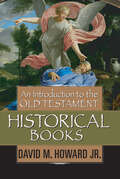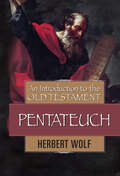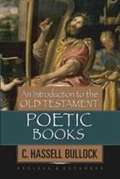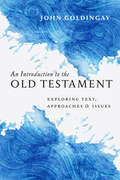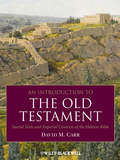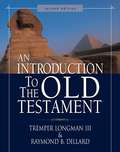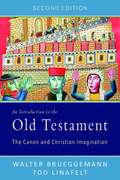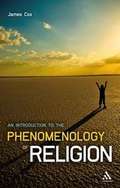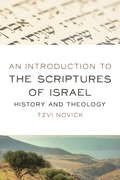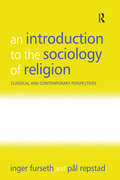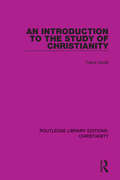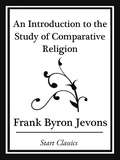- Table View
- List View
An Introduction to the Old Testament Historical Books
by David M. HowardRich rewards await readers who dig deep into the historical books of the Old Testament. Incredible events, amazing love stories, larger-than-life personalities, and deep theological themes are just some of the treasures found in Joshua, Judges, Ruth, 1 and 2 Samuel, 1 and 2 Kings, 1 and 2 Chronicles, Ezra, Nehemiah, Esther. <p><p> These books tell the story of the nation of Israel and the God who loves her, punishes her, and always brings this recalcitrant people back to Himself. It is really the story of all of us. <p><p> David M. Howard Jr. provides an in-depth introduction to the Old Testament historical books, focusing first on the overarching themes of historical narrative in general. He then turns his attention to each book, considering topics like: <p>• Authorship and date <p>• Place in the canon <p>• Historical and cultural context <p>• Theology of the book <p>• Special issues pertaining to the book <p><p> From the conquest of Canaan to the fall of Jerusalem, from war to peace and back to war, from kings and queens to farmers and housewives—David Howard covers it all in this invaluable introduction to the Old Testament historical books.
An Introduction to the Old Testament Historical Books
by David M. Howard Jr.Rich rewards await readers who dig deep into the historical books of the Old Testament. Incredible events, amazing love stories, larger-than-life personalities and deep theological implications and themes are just part of the t treasure that awaits readers of Joshua, Judges, Ruth, 1 & 2 Samuel, 1 & 2 Kings, 1 & 2 Chronicles, Ezra, Nehemiah, Esther.These books tell the story of the nation of Israel and the God who loves her, punishes her, and always brings this recalcitrant people back to Himself. It is really the story of all of us.David M. Howard Jr. provides an in-depth introduction to the Old Testament historical books, focusing first on the overarching themes of historical narrative in general. He then turns his attention to each book.From the conquest of Canaan to the fall of Jerusalem, from war to peace and back to war, from kings and queens to farmers and housewives--David Howard covers it all in this invaluable introduction to the Old Testament historical books.
An Introduction to the Old Testament Historical Books
by David M. Howard Jr.Rich rewards await readers who dig deep into the historical books of the Old Testament. Incredible events, amazing love stories, larger-than-life personalities and deep theological implications and themes are just part of the t treasure that awaits readers of Joshua, Judges, Ruth, 1 & 2 Samuel, 1 & 2 Kings, 1 & 2 Chronicles, Ezra, Nehemiah, Esther.These books tell the story of the nation of Israel and the God who loves her, punishes her, and always brings this recalcitrant people back to Himself. It is really the story of all of us.David M. Howard Jr. provides an in-depth introduction to the Old Testament historical books, focusing first on the overarching themes of historical narrative in general. He then turns his attention to each book.From the conquest of Canaan to the fall of Jerusalem, from war to peace and back to war, from kings and queens to farmers and housewives--David Howard covers it all in this invaluable introduction to the Old Testament historical books.
An Introduction to the Old Testament Pentateuch
by Herbert WolfThe Pentateuch--Genesis, Exodus, Leviticus, Numbers, Deuteronomy--are the vital first books in the Bible. understanding the scope, meaning, and events of these five books is integral to understanding the whole of Scripture that follows.Old Testament expert Herbert Wolf provides layreaders and scholars alike with a strong undergirding of understanding and knowledge in this introduction that reveals both the seriousness and excitement of the Pentateuch. Readers will find Adam, Abraham, Joseph, Moses and Joshua in these pages, as well as terrible sin and glorious forgiveness, bloody sacrifices and battles, deadly betrayal and life-giving hope.Wolf first addresses the overarching themes that flow through the Pentateuch, with special attention given to Moses as author of the five books. He then addresses each book specifically, covering topics such as purpose and scope, and literary structure. He tailors additional study to each specific book. This book contributes significantly to a clear, deep understanding of the Bible's first five books.
An Introduction to the Old Testament Pentateuch
by Herbert WolfThe Pentateuch--Genesis, Exodus, Leviticus, Numbers, Deuteronomy--are the vital first books in the Bible. understanding the scope, meaning, and events of these five books is integral to understanding the whole of Scripture that follows.Old Testament expert Herbert Wolf provides layreaders and scholars alike with a strong undergirding of understanding and knowledge in this introduction that reveals both the seriousness and excitement of the Pentateuch. Readers will find Adam, Abraham, Joseph, Moses and Joshua in these pages, as well as terrible sin and glorious forgiveness, bloody sacrifices and battles, deadly betrayal and life-giving hope.Wolf first addresses the overarching themes that flow through the Pentateuch, with special attention given to Moses as author of the five books. He then addresses each book specifically, covering topics such as purpose and scope, and literary structure. He tailors additional study to each specific book. This book contributes significantly to a clear, deep understanding of the Bible's first five books.
An Introduction to the Old Testament Poetic Books
by C. Hassell BullockThe poetic books of the Old Testament--Job, Psalms, Proverbs, Ecclesiastes, and the Song of Solomon--are often called humankind's reach toward God. The other books of the Old Testament picture God's reach toward man through the redemptive story. Yet these five books reveal the very heart of men and women struggling with monumental issues such as suffering, sin, forgiveness, joy, worship, and the passionate love between a man and woman.
An Introduction to the Old Testament Poetic Books
by C. Hassell BullockThe poetic books of the Old Testament--Job, Psalms, Proverbs, Ecclesiastes, Song of Solomon--are often called humankind's reach toward God. The other books of the Old Testament picture God's reach toward man through the redemptive story. Yet these five books reveal the very hear of men and women struggling with monumental issues such as suffering, sin, forgiveness, joy, worship, and the passionate love between a man and woman.C. Hassell Bullock, a noted Old Testament scholar, delves deep into the hearts of the five poetic books, offering readers helpful details such as harmeneutical considerations for each book, theological content and themes, detailed analysis of each book, and cultural perspectives.Hebrew is a language of "intrinsic musical quality that naturally supports poetic expression," says Bullock in his introduction. That poetic expression comes from the heart of the Old Testament writers and reaches all of us exactly where we are in our own struggles and joys.
An Introduction to the Old Testament Poetic Books
by C. Hassell BullockThe poetic books of the Old Testament--Job, Psalms, Proverbs, Ecclesiastes, Song of Solomon--are often called humankind's reach toward God. The other books of the Old Testament picture God's reach toward man through the redemptive story. Yet these five books reveal the very hear of men and women struggling with monumental issues such as suffering, sin, forgiveness, joy, worship, and the passionate love between a man and woman.C. Hassell Bullock, a noted Old Testament scholar, delves deep into the hearts of the five poetic books, offering readers helpful details such as harmeneutical considerations for each book, theological content and themes, detailed analysis of each book, and cultural perspectives.Hebrew is a language of "intrinsic musical quality that naturally supports poetic expression," says Bullock in his introduction. That poetic expression comes from the heart of the Old Testament writers and reaches all of us exactly where we are in our own struggles and joys.
An Introduction to the Old Testament Prophetic Books
by C. Hassell BullockThe Old Testament prophets spoke to Israel in times of historical and moral crisis. They saw themselves as being a part of a story that God was weaving throughout history--a story of repentance, encouragement, and a coming Messiah. In this updated introductory book, each major and minor prophet and his writing are clustered with the major historical events of their time. Our generational distance from the age of the prophets might seem to be a measureless chasm. Yet we dare not make the mistake of assuming that passing years have rendered irrelevant not only the Old Testament prophets, but also the God who comprehends, spans, and transcends all time. In these pages, C. Hassell Bullock presents a clear picture of some of history's most profound spokesmen--the Old Testament prophets--and the God who shaped them.
An Introduction to the Old Testament Prophetic Books
by C. Hassell BullockThe Old Testament prophets spoke to Israel in times of historical and moral crisis. They saw themselves as being a part of a story that God was weaving throughout history--a story of repentance, encouragement, and a coming Messiah. In this updated introductory book, each major and minor prophet and his writing are clustered with the major historical events of their time. Our generational distance from the age of the prophets might seem to be a measureless chasm. Yet we dare not make the mistake of assuming that passing years have rendered irrelevant not only the Old Testament prophets, but also the God who comprehends, spans, and transcends all time. In these pages, C. Hassell Bullock presents a clear picture of some of history's most profound spokesmen--the Old Testament prophets--and the God who shaped them.
An Introduction to the Old Testament Prophetic Books
by C. Hassell BullockThe Old Testament prophets spoke to Israel in times of historical and moral crisis. They saw themselves as being a part of a story that God was weaving throughout history--a story of repentance, encouragement, and a coming Messiah. In this updated introductory book, each major and minor prophet and his writing are clustered with the major historical events of their time. Our generational distance from the age of the prophets might seem to be a measureless chasm. Yet we dare not make the mistake of assuming that passing years have rendered irrelevant not only the Old Testament prophets, but also the God who comprehends, spans, and transcends all time. In these pages, C. Hassell Bullock presents a clear picture of some of history's most profound spokesmen--the Old Testament prophets--and the God who shaped them.
An Introduction to the Old Testament: Exploring Text, Approaches & Issues
by John GoldingayEnter the classroom of one of today?s premier biblical interpreters as he shares his infectious love for the Old Testament. This is where you begin the adventure of exploring the Bible?s First Testament. Some Old Testament introductions tell you what you could have seen for yourself. They might recount in detail what other scholars have said, and then tell you what you should think about it. But with refreshing directness, John Goldingay outfits you with basic knowledge, points out the main approaches, outlines the primary issues and then sets you loose to explore the terrain for yourself. Traverse the grand tapestry of the Torah. Discern the art and grain of biblical narrative. Listen to the cries, confessions and cadences of the Psalms. Probe the varied textures of wisdom literature. And ponder the prophets in the darkening nightmare of exile and the distant light of hope. More workbook than handbook, this introduction to the Old Testament is rooted in decades of tried and proven teaching. Goldingay displays a robust confidence in the truthfulness of Scripture combined with a refreshing trust in the reader's ability to grapple responsibly with the Old Testament. Even when the text hits you sideways, Goldingay encourages you not to squirm or run, but to grab hold and go deeper. Under his expert guidance the cordon between faith and criticism swings open into theological and spiritual insight.
An Introduction to the Old Testament: Sacred Texts and Imperial Contexts of the Hebrew Bible (Journal For The Study Of The Old Testament Supplement #No. 225.)
by David M. CarrThis comprehensive, introductory textbook is unique in exploring the emergence of the Hebrew Bible in the broader context of world history. It particularly focuses on the influence of pre-Roman empires, empowering students with a richer understanding of Old Testament historiography. Provides a historical context for students learning about the development and changing interpretations of biblical texts Examines how these early stories were variously shaped by interaction with the Mesopotamian and Egyptian, Assyrian, Babylonian, Persian, and Hellenistic empires Incorporates recent research on the formation of the Pentateuch Reveals how key biblical texts came to be interpreted by Jewish, Christian, and Muslim faiths Includes numerous student-friendly features, such as study questions, review sections, bibliographies, timelines, and illustrations and photos
An Introduction to the Old Testament: Second Edition
by Tremper Longman IIIAn upper-level introduction to the Old Testament that offers students a thorough understanding of three key issues: historical background, literary analysis, and theological message.This second edition of An Introduction to the Old Testament integrates recent developments in Old Testament scholarship. It has many distinctive features that set it apart from other introductions to the Old Testament:It's committed to a theologically evangelical perspective.Emphasizes "special introduction"—the study of individual books.Interacts in an irenic spirit with the historical-critical method.Features points of research history and representative scholars rather than an exhaustive treatment of past scholarship.Deals with the meaning of each book, not in isolation but in a canonical context.Probes the meaning of each book in the setting of its culture.Including callouts, charts, and graphs, An Introduction to the Old Testament is written with an eye to understanding the nature of Old Testament historiography.Perfect for seminary students, professors, and Bible teachers and ministry leaders, as well as anyone looking for an in-depth and balanced approach to Old Testament study.
An Introduction to the Old Testament: The Canon and Christian Imagination (Second Edition)
by Walter Brueggemann Tod LinafeltIn this updated edition of the popular textbook, Walter Brueggemann and Tod Linafelt introduce the reader to the broad theological scope of the Old Testament, treating some of the most important issues and methods in contemporary biblical interpretation. This clearly written textbook focuses on the literature of the Old Testament as it grew out of religious, political, and ideological contexts over many centuries in Israel's history. Covering every book in the Old Testament (arranged in canonical order), the authors demonstrate the development of theological concepts in biblical writings from the Torah through post-exilic Judaism. This introduction invites readers to engage in the construction of meaning as they venture into these timeless texts.
An Introduction to the Phenomenology of Religion
by James L. CoxIn this revised edition, the author provides an easily accessible introduction to the phenomenology of religion, which he contends continues as a foundational method for the academic study of religion in the twenty-first century. After dealing with the problematic issue of defining religion, he describes the historical background to phenomenology by tracing its roots to developments in philosophy and the social sciences in the early twentieth century. The phenomenological method is then outlined as a step-by-step process, which includes a survey of the important classifications of religious behavior. The author concludes with a discussion of the place of the phenomenology of religion in the current academic climate and argues that it can be aligned with the growing scholarly interest in the cognitive science of religion.
An Introduction to the Philosophy of Religion
by Michael J. Murray Michael C. ReaAn Introduction to the Philosophy of Religion provides a broad overview of the topics which are at the forefront of discussion in contemporary philosophy of religion. Prominent views and arguments from both historical and contemporary authors are discussed and analyzed. The book treats all of the central topics in the field, including the coherence of the divine attributes, theistic and atheistic arguments, faith and reason, religion and ethics, miracles, human freedom and divine providence, science and religion, and immortality. In addition it addresses topics of significant importance that similar books often ignore, including the argument for atheism from hiddenness, the coherence of the doctrines of the Trinity and the Incarnation, and the relationship between religion and politics. It will be a valuable accompaniment to undergraduate and introductory graduate-level courses.
An Introduction to the Philosophy of Religion (Third Edition)
by Brian Davies<p>The third edition of An Introduction to the Philosophy of Religion provides a critical examination of some fundamental questions posed by religious belief: What does belief in God amount to? Can God's existence be proved? Is there life after death? <p>Brian Davies considers these questions and many others, sometimes offering provocative answers of his own, but more often giving readers room to each independent conclusions. He explains how a range of thinkers have approached the subject -- including Anselm, Aquinas, Descartes, Leibniz, Hume, and Kant -- and also discusses how contemporary author now engage with the issues involved. Completely revised to cover the latest developments in the field, the new edition of this established textbook will prove the ideal introduction for all students of the philosophy of religion.</p>
An Introduction to the Scriptures of Israel: History and Theology
by Tzvi NovickIn this distinctive textbook for Hebrew Bible courses, author Tzvi Novick&’s approach is thematic rather than chronological. Sorting the books according to their historical context, theological claims, and literary conventions, Novick examines and elucidates the historical and intellectual development of the Hebrew Bible. With attentiveness to both historical-critical and traditional-canonical approaches, An Introduction to the Scriptures of Israel focuses on the dichotomy of the particular and the universal. It shows how this dichotomy impacts each book&’s style and content and how it informs the development of Jewish and Christian traditions. This nontraditional textbook is coherent, engaging, and succinct—a perfect resource for any introductory Hebrew Bible course.ContentsPreface Abbreviations 1. Three Introductions 2. The Wisdom Tradition: Religion without Revelation 3. Revelation and Love: The Patriarchal Narratives and the Song of Songs 4. Joseph and Narrative 5. The Exodus: Freedom and Sonship 6. Sinai: Covenant and Code 7. The Problem of Monarchy: Samuel and Kings 8. Condemning Israel, Sparing the Nations: Amos and Jonah 9. Eden and the Art of Reading 10. Priestly Theology and Holy Space 11. Exile and Return: Prophetic Visions 12. The Consolidation of Judaism: Temple and Torah 13. Violence and Identity: Joshua and Judges 14. Jews, Gentiles, and Gender: Esther, Ruth, Ezra, and Nehemiah 15. Apocalyptic: Daniel and the Dead Sea Scrolls 16. The Israelite at Prayer: The Book of PsalmsSubject Index Scripture and Other Ancient Sources Index
An Introduction to the Scriptures of Israel: History and Theology
by Tzvi NovickIn this distinctive textbook for Hebrew Bible courses, author Tzvi Novick&’s approach is thematic rather than chronological. Sorting the books according to their historical context, theological claims, and literary conventions, Novick examines and elucidates the historical and intellectual development of the Hebrew Bible. With attentiveness to both historical-critical and traditional-canonical approaches, An Introduction to the Scriptures of Israel focuses on the dichotomy of the particular and the universal. It shows how this dichotomy impacts each book&’s style and content and how it informs the development of Jewish and Christian traditions. This nontraditional textbook is coherent, engaging, and succinct—a perfect resource for any introductory Hebrew Bible course.ContentsPreface Abbreviations 1. Three Introductions 2. The Wisdom Tradition: Religion without Revelation 3. Revelation and Love: The Patriarchal Narratives and the Song of Songs 4. Joseph and Narrative 5. The Exodus: Freedom and Sonship 6. Sinai: Covenant and Code 7. The Problem of Monarchy: Samuel and Kings 8. Condemning Israel, Sparing the Nations: Amos and Jonah 9. Eden and the Art of Reading 10. Priestly Theology and Holy Space 11. Exile and Return: Prophetic Visions 12. The Consolidation of Judaism: Temple and Torah 13. Violence and Identity: Joshua and Judges 14. Jews, Gentiles, and Gender: Esther, Ruth, Ezra, and Nehemiah 15. Apocalyptic: Daniel and the Dead Sea Scrolls 16. The Israelite at Prayer: The Book of PsalmsSubject Index Scripture and Other Ancient Sources Index
An Introduction to the Sociology of Religion: Classical and Contemporary Perspectives
by Inger Furseth Pål RepstadIs it true that religion is weakening in modern times, or are we facing religious resurgence? What is fundamentalism? How does it emerge and grow? What role does religion play in ethnic and national conflicts? Is religion a fundamental driving force or do political leaders use religion for their own purposes? Do all religions oppress women? These are some of the questions addressed in this book. An Introduction to the Sociology of Religion provides an overview of sociological theories of contemporary religious life. Some chapters are organized according to topic. Others offer brief presentations of classical and contemporary sociologists from Karl Marx to Zygmunt Bauman and their perspectives on social life, including religion. Throughout the book, illustrations and examples are taken from several religious traditions.
An Introduction to the Sociology of Religion: Classical and Contemporary Perspectives
by Inger Furseth Pål RepstadWhat are religion and nonreligion? How do fundamentalism and religious radicalization emerge and grow? How do social class, gender, sexuality, race, ethnicity, and other factors affect religious beliefs, practices, and organizations? Is religion a fundamental driving force or do political leaders use religion for their own purposes? In exploring these pertinent questions, An Introduction to the Sociology of Religion provides an overview of sociological theories of contemporary religious life. Theoretical discussion is accompanied by presentations of empirical research from several religious traditions in many parts of the world. The sociology of religion is linked closely to developments in general sociology. Some chapters are organized according to topic, while others offer brief presentations of classical and contemporary sociologists from Karl Marx to Patricia Hill Collins and their perspectives on social life, including on religion. This second edition has been thoroughly updated throughout with new chapters on religion and social inequalities, social and religious movements, and extremism. Covering classical sociology of religion as well as contemporary debates and topics, this book is ideal reading for students approaching the sociology of religion for the first time.
An Introduction to the Study of Christianity
by Frank DoddOriginally published in 1938, An Introduction to the Study of Christianity is a consideration of what is truly essential in the Christian faith. The book provides a detailed survey of key elements relating to the origin and growth of Christianity, and puts forward the argument that any apparent blemishes or mistakes are the result of human imperfection and misunderstanding of the real teaching of Jesus and his immediate followers, rather than of any shortcomings in the teaching itself. It first sets out the foundations of Christianity and then calls attention to the different interpretations that successive generations of Christians have placed on them. Exploring the history of the Christian faith up to the 1930s, An Introduction to the Study of Christianity will appeal to those with an interest in the history of religion, Christianity, theology, and religious studies.
An Introduction to the Study of Comparative Religion (Start Classics)
by Frank Byron JevonsThe Hartford-Lamson Lectures on The Religions of the World are delivered at Hartford Theological Seminary in connection with the Lamson Fund, which was established by a group of friends in honor of the late Charles M.Lamson, D.D., sometime President of the American Board of Commissioners for Foreign Missions, to assist in preparing students for the foreign missionary field. The Lectures are designed primarily to give to such students a good knowledge of the religious history, beliefs, and customs of the peoples among whom they expect to labor. As they are delivered by scholars of the first rank, who are authorities in their respective fields, it is expected that in pubUshed form they will prove to be of value to students generally.
An Introduction to the Study of Mysticism
by Richard H. Jones2022 CHOICE Outstanding Academic TitleThe purpose of this book is to fill a gap in contemporary mystical studies: an overview of the basic ways to approach mystical experiences and mysticism. It discusses the problem of definitions of “mystical experiences” and “mysticism” and advances characterizations of “mystical experiences” in terms of certain altered states of consciousness and “mysticism” in terms of encompassing ways of life centered on such experiences and states. Types of mystical experiences, enlightened states, paths, and doctrines are discussed, as is the relation of mystical experiences and mysticism to religions and cultures. The approaches of constructivism, contextualism, essentialism, and perennialism are presented. Themes in the history of the world’s major mystical traditions are set forth. Approaches to mystical phenomena in sociology, psychology, gender studies, and neuroscience are introduced. Basic philosophical issues related to whether mystical experiences are veridical and mystical claims valid, mystics’ problems of language, art, and morality are laid out. Older and newer comparative approaches in religious studies and in Christian theology are discussed, along with postmodernist objections. The intended audience is undergraduates and the general public interested in the general issues related to mysticism.

